Bamboo Natural Building Course at Bamboo School Costa Rica
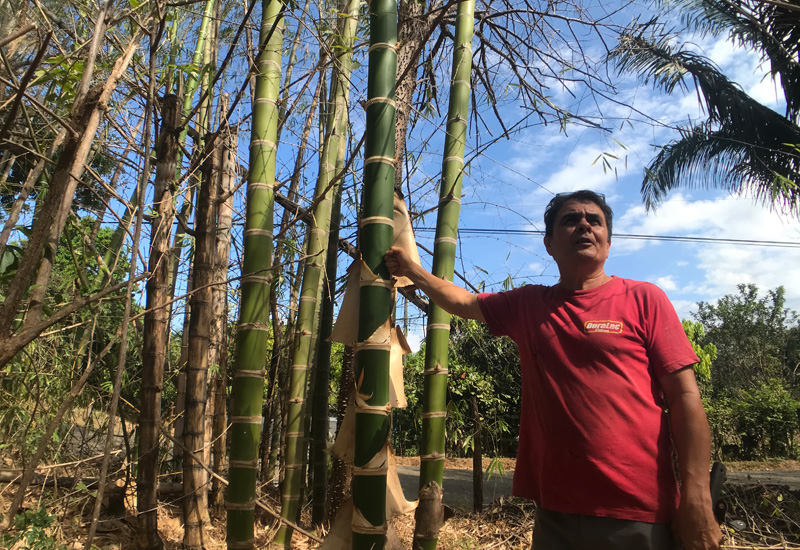
Back in February 2020 I headed to Costa Rica for a week-long timber framing course at Rancho Mastatal and, since I was flying all the way out there, I was pretty keen to tack on something else to make the trip a bit more worthwhile. I’m not so into travel for travel’s sake these days and I much prefer doing something or learning new things to backpacking around and looking at waterfalls, so my internet search began! Luckily, Costa Rica is packed with cool projects, communities, and natural building opportunities and after a bit of searching I found Bamboo School Costa Rica. Bamboo as a building material has intrigued me for many years but I’ve never had an opportunity to work with it before, so I jumped at the opportunity of taking this course the following week.
Bamboo School was, I think, fairly new when I took my course. The school’s founder and teacher, Rodolfo Saenz, has travelled all around the region teaching courses and he’s generally considered to be one of the best bamboo craftsmen in Costa Rica. The school is located at his home in a rural area near a town called Orotina and, instead of travelling to different areas to teach on other people’s projects, he’s decided to branch out on his own with the help of his wife, Ria, and some other family members to make sure guests are well taken care of. Their impressive house (made from bamboo!) was a lovely place to stay and the food was amazing but, when I took the course, I felt like they had a bit of work to do on smoothing out the learning experience.
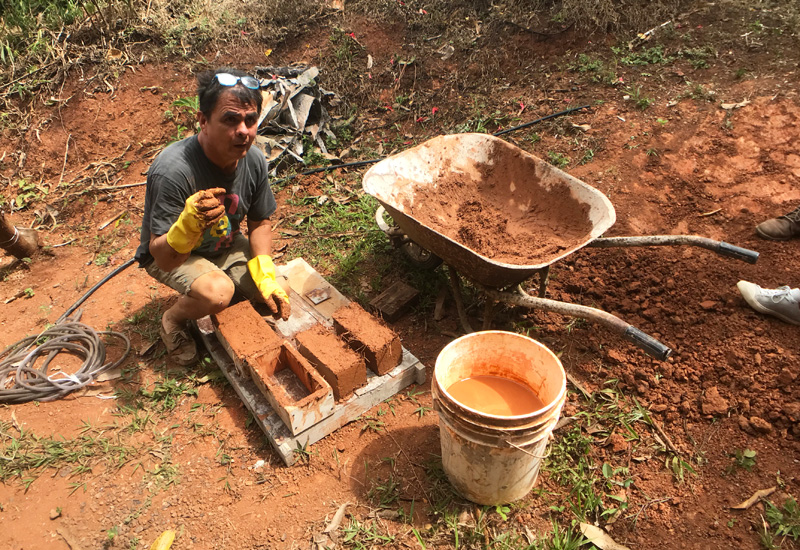
This has been a bit of a tough post for me to write. I’ve um-ed and ah-ed about what to say about the week-long course I took at Bamboo School because it wasn’t exactly what I was hoping it would be. I guess it’s another life lesson that arriving with expectations is never a good idea! I’d had high hopes for this course but it wasn’t really a good fit for me. The other students seemed very happy with it, though, so I’ve chalked it up to me not doing enough research or asking the right questions before signing up. I wonder if my experience on this course was doomed from the start due to having previously been at Rancho Mastatal where I met lots of fantastic people and we were taught in exactly the way I learn best – by doing. It was probably the best course experience I’ve ever had and it was going to be a tough act to follow, for sure.
After spending a glorious week offline and fully engaged with the work and everyone around me, it was a bit of a bummer to arrive onto the bamboo course to a group of people with their faces in their phones. Plus, a lot of the issues I had boiled down to the fact that I don’t speak Spanish. This is absolutely nobody’s fault but my own, but it sucks pretty hard when everyone prefers to speak in a language you don’t understand. Nobody wants to be the arse that demands people socialise in English, so I spent a lot of my time in bored silence as everyone chattered in jovial conversation. It seemed like everyone was having a lovely time, but I found it to be quite hard work and isolating.
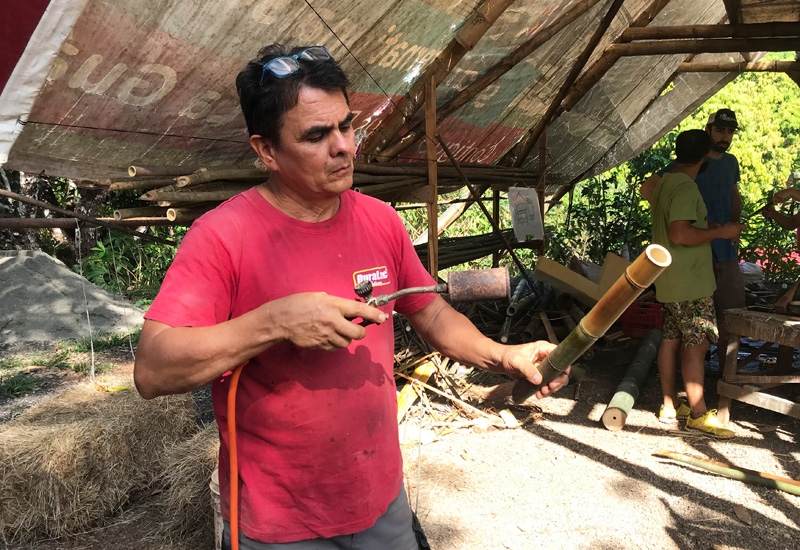
Another and more important language issue was that the course was mostly taught in Spanish. Perhaps I should have asked more questions before I arrived about which language the course would be run in but the website and all communication were both done in English, so I sort of assumed the course would also be in English. It seemed to start out that way but, since much of the class spoke Spanish (except for myself and two guys – one of whom left the course early), things quickly drifted to being taught mostly in Spanish. Rodolfo was good about offering concise translations to keep us up to speed, but as the week wore on these became fewer and fewer and another student took pity on me and took over the job of translating. This arrangement worked ok and and I feel like I learned what I needed to know – any questions I asked were always answered – but it just made the whole experience quite tedious and dull. A lot of the course was spent with Rodolfo showing techniques and processes while everyone chatted in Spanish which I found to be a weird kind of torture.
Another problem I had that led to the course being dull for me was the lack of student participation. A lot of the time was spent watching and, when there were things to do like preparation or helping with a demonstration, it seemed like there were already two helpers assigned to this. I’m used to natural building courses that are very participatory, so having things set up as more of a demonstration was new to me and not something I enjoyed.
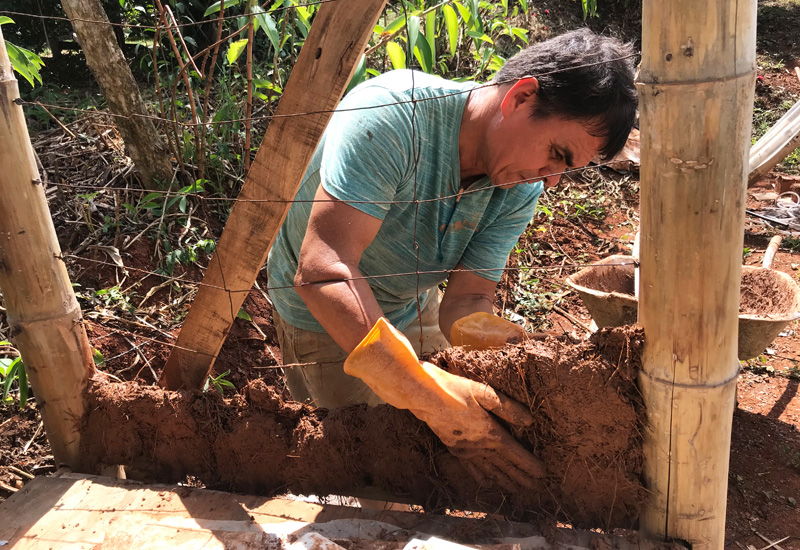
One thing I can say for certain is that Rodolfo really is the man to learn from if bamboo is your thing. He’s extremely passionate and experienced and you’ll gain a huge amount of information, even if it is mostly through watching. He can put up a building with an equal amount of skill as putting together a beautiful piece of furniture and he has a lot to teach. I took loads of notes and videos of the cool things he was showing us and I also learned several new approaches on how to do things I’d already done before (like a few new techniques for wattle and daub).
He and his wife were talking about possibly running a longer-term apprenticeship in the future where students would help to build actual structures on their land. If you’re interested in building with bamboo but want a practical, real-world project to work on then I think this would be an amazing way to learn! Rodolfo also seems to pop up as a co-teacher on other courses run through Natural Building Costa Rica and I’m told there’s more theory taught on those courses and then you work together to build a structure. If you’d prefer to work on an actual building but also want to tap into Rodolfo’s vast experience, I think you’d have an excellent experience on a course with Natural Building Costa Rica.
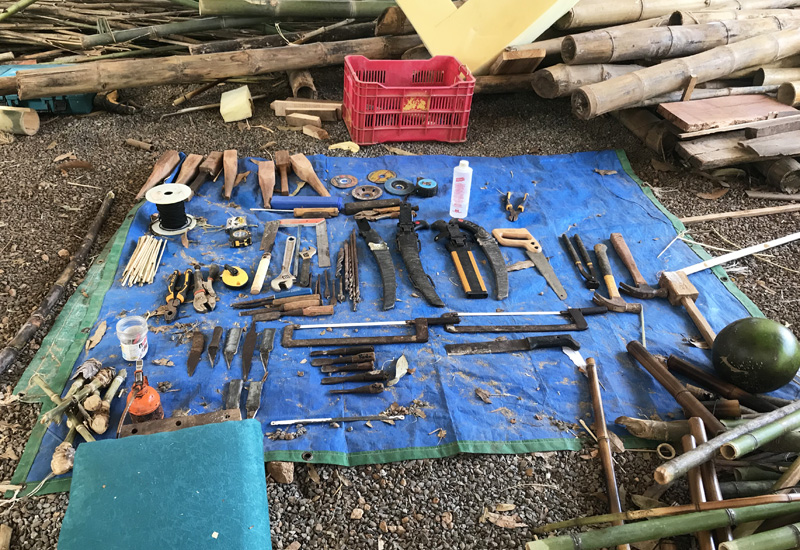
New Things I Did
So much! I’ve never worked with bamboo before so everything with this material was a learning experience.
- I’ve never really handled bamboo before and it was interesting to see how the material feels and how it reacts when you’re working with it. It wants to split down its length which introduces lots of interesting design challenges and opportunities. Learning how to work best with the material was definitely new to me and I was able to figure it out just enough to carve a small scoop which was fun.
- There are quite a few tools I’ve never laid my hands on before that I got to try. Rodolfo even makes his own knives to do certain tasks with the bamboo so that was cool.
- Being in warm Costa Rica, dealing with things like insulation and thermal mass aren’t as important as they are in temperate climates. This means that wattle and daub (or some variation of it) is the most common way to build walls in these parts. Most of Rancho Mastatal’s buildings use wattle and daub and Rodolfo showed us several techniques I’d never used before.
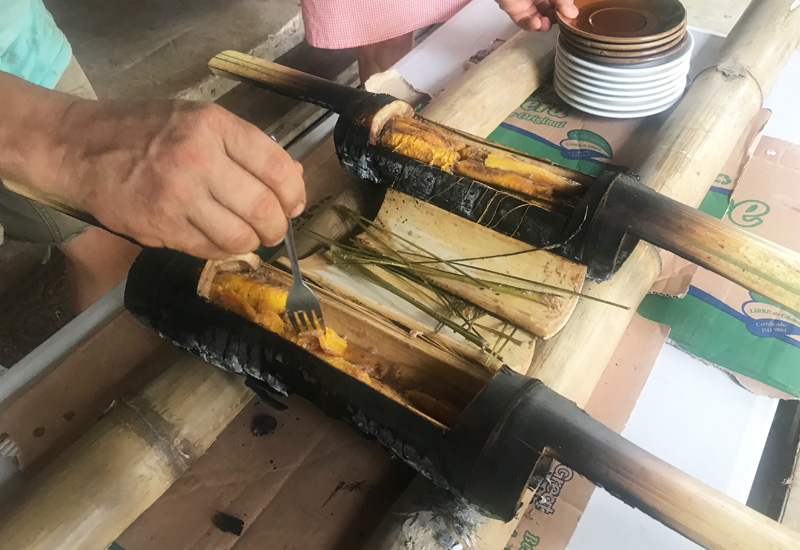
Highlights
- On the first day of the course we went to a couple of bamboo plantations to see massive bunches of bamboo growing. Rodolfo gave us lots of info on how and when to harvest bamboo, some of the different types and what they’re best for, and info on the crazy speed it grows at. It was cool to go to the source to harvest some of what we’d be using on the course.
- Bamboo is an incredibly interesting and versatile material. I loved seeing all of the different ways it could be used. I was especially impressed with the technique to make floors.
- We had a little demonstration on how to make a simple vessel to cook over the fire inside bamboo which was cool.
- The food they served during the course was simple but very delicious. Breakfast, lunch, and dinner were all amazing all the time. Everything was vegetarian and I didn’t miss meat at all.
- Rodolfo and Ria built their house from bamboo and cob and it’s beautiful! It’s known locally in the area as ‘Casa Bamboo’ and when I was lost in a taxi, that’s all the person had to hear before pointing us in the right direction. I loved seeing their place from the inside and seeing how things fit together. Plus they’ve got a super cool indoor/outdoor shower that’s very inspirational and gave me some ideas.
- Rodolfo, Ria, and their family are lovely and, even though the course wasn’t for me, I really enjoyed getting to know them. They’re all very interesting people and the hospitality they offered us in their home was really special.
- Though it’s not what I signed up for, I ended up spending a lot of time carving spoons out of wood and scoops out of bamboo. It was cool to experiment with bamboo carving and Rodolfo was impressed with my mini scoop design (though I actually subconsciously stole the design from a Rancho Mastatal compost toilet sawdust scoop).
- Rodolfo had some very interesting wattle and daub techniques that went beyond anything I’d learned before so it was cool to see those. It highlighted the fact that there are many different ways to do things in the world of natural building. There’s no ‘one size fits all’ answer and experimenting and trying different ways can lead to beautiful, practical results.
- Rodolfo also showed us some very interesting mixes involving paper which was interesting. He showed us a mix that was half clay and half paper that was so strong you could drill a screw in and out of it without any damage or crumbling of the wall which, for natural building nerds, is sort of a big deal.
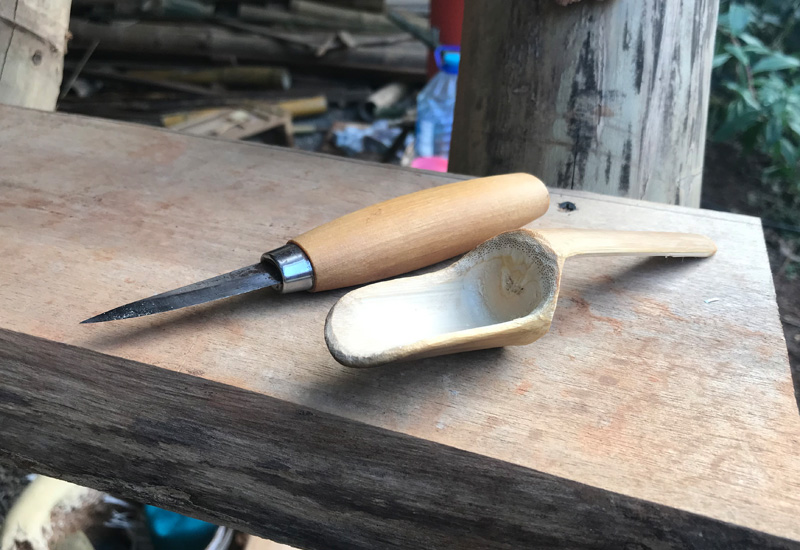
Challenges
Unfortunately, the course wasn’t really structured in a way that I enjoyed and there were a lot of challenges. I asked Ria if she’d like some suggestions for how I think the course could be improved and she took me up on that offer so I hope they take any useful tips on board because Rodolfo is an incredibly knowledgeable person, their place is amazing, and the course could be truly excellent.
- I was bored. During class time, mostly Spanish was spoken and it was the same during the meals. I made some effort to include myself and to try to have people speak in English but I gave up after awhile and spent a lot of time with my book and carving spoons. It’s nobody’s job but my own to keep myself entertained, but the language barrier made things tricky and it became easier just to opt out and focus on my own things instead of feeling like I was pressuring people to switch to speaking English.
- We got to see a lot of techniques but there wasn’t a lot of hands-on action. Much of the course was watching Rodolfo do things and it wasn’t really set up for us to get a lot of practice on each technique. It was cool to see him make a bamboo bench and to then practice some of the joinery and lashing, but it would have been more cool to make our own, smaller and easier thing alongside him, rather than just observing him work. Participating is just the way I prefer to learn, so spending a bunch of time observing wasn’t so interesting for me. There were opportunities to practice things but practicing without an end goal in mind isn’t massively inspiring for me, I’ve learned.
- A lot of time was spent waiting as Rodolfo and his helpers prepared things. When he was showing us how to make a bamboo floor, for example, we spent 45 minutes standing around watching him use a table saw, and then another 30 minutes in the morning the next day. Just standing in silence… watching him saw. I feel like more preparation could have been done to have certain materials ready so that we weren’t standing around so much.
- This is nothing to do with the course but more a realisation of my own. Since I already have a good amount of natural building experience, I’m not sure it really made sense to take a course teaching natural building techniques. Perhaps I thought that more is better but, in this case, when you know how to mix cob and make wattle and daub walls, bricks, etc, it’s not that helpful to learn it again since the methods are mostly the same. Sure, people can have different techniques and little tips, but I think it would have been better to have found a course focusing only on bamboo.
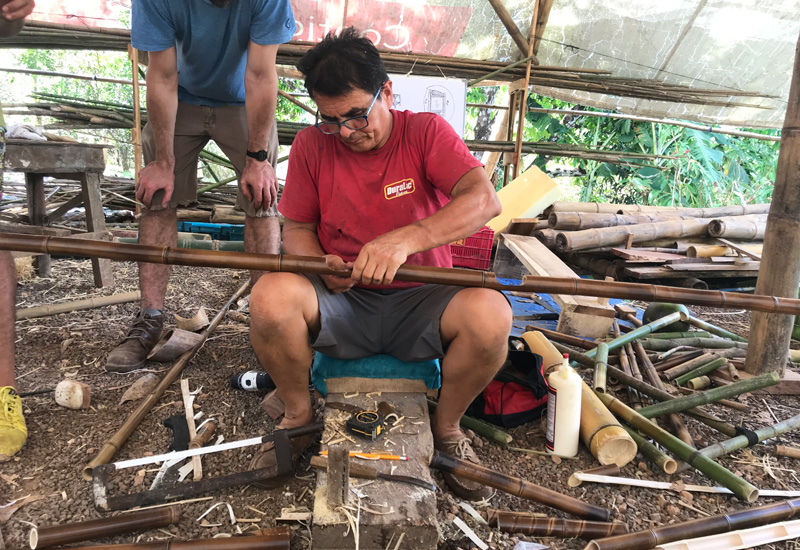
My time at Bamboo School inspired me to write my previous article on choosing a natural building course so now, going forward, hopefully I can follow my own advice in order to make sure any future courses I take will be well-suited to me and my learning style. I want to stress that the other students seemed to have an awesome time… I really do think it was the language barrier that mostly led to me not having the best experience, and that’s really not their problem. At their request, I did send a bit of feedback their way so maybe they’ll make some changes to accommodate us learning-by-doing, English-speaking types. Or maybe they’ll stick with what they’re doing… either way, I can’t wait to see how the school grows and develops and I wish them lots of success!
Bamboo really is a remarkable material and I hope to get another opportunity to work with it one of these days!


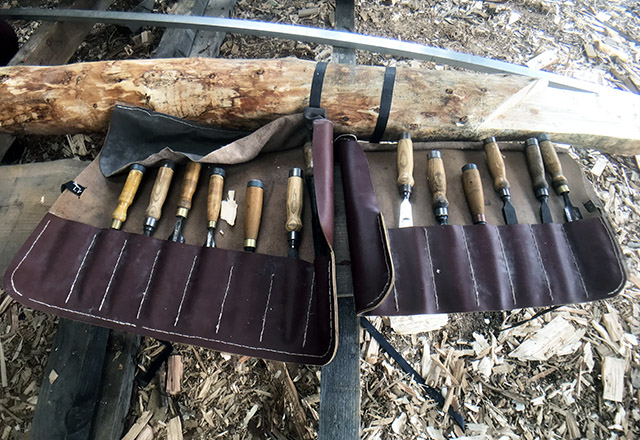
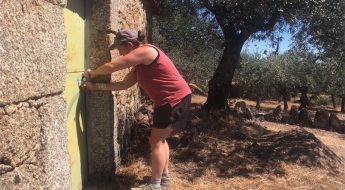
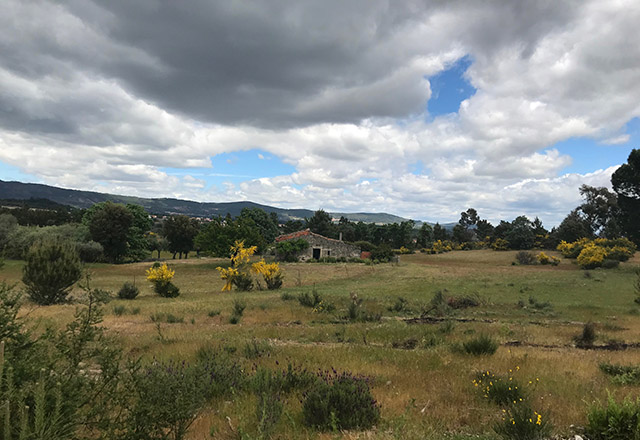
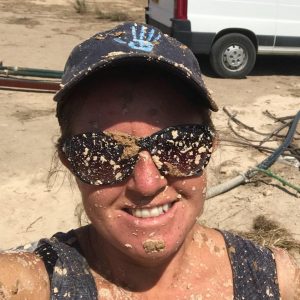
Leave a Comment